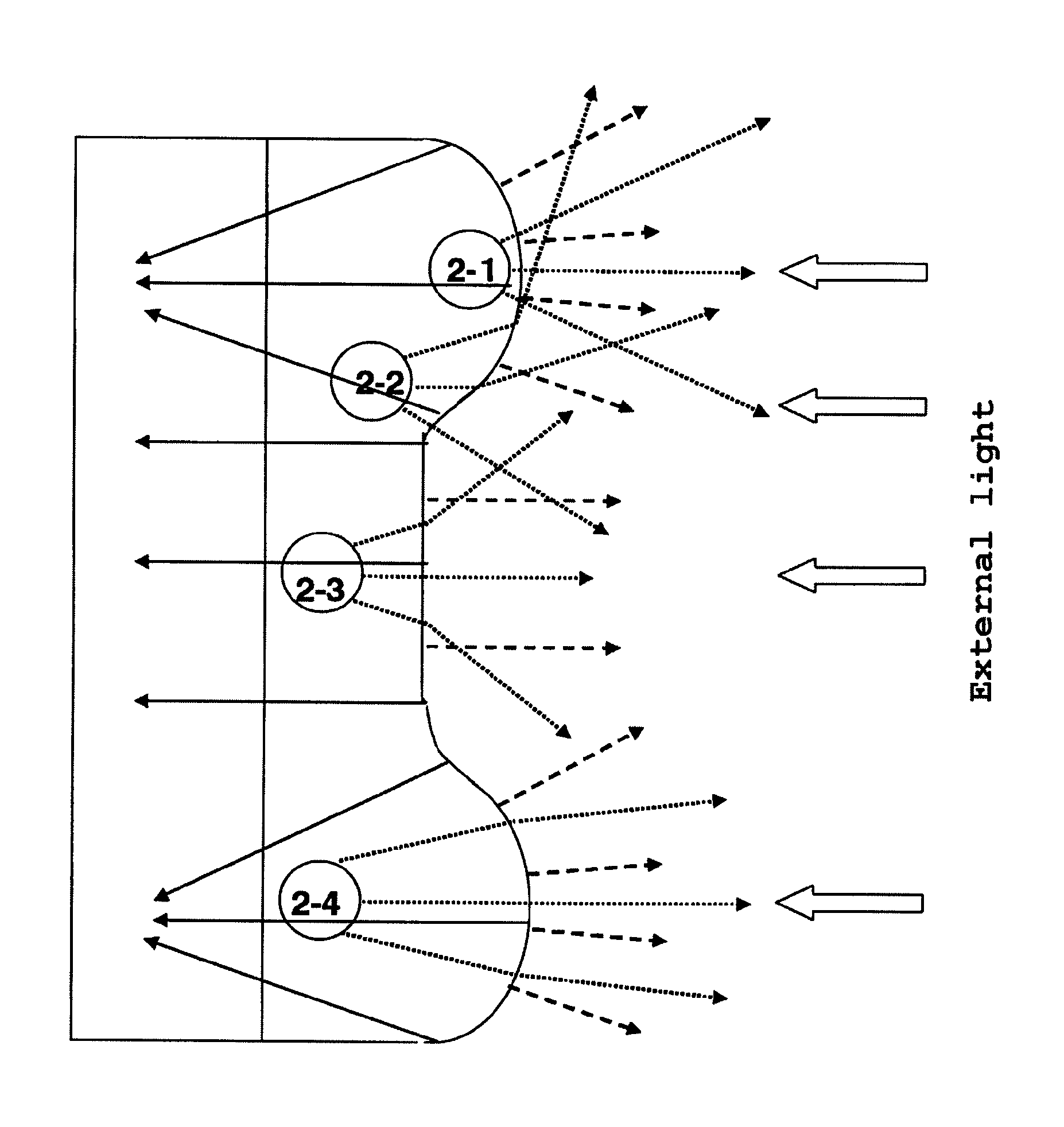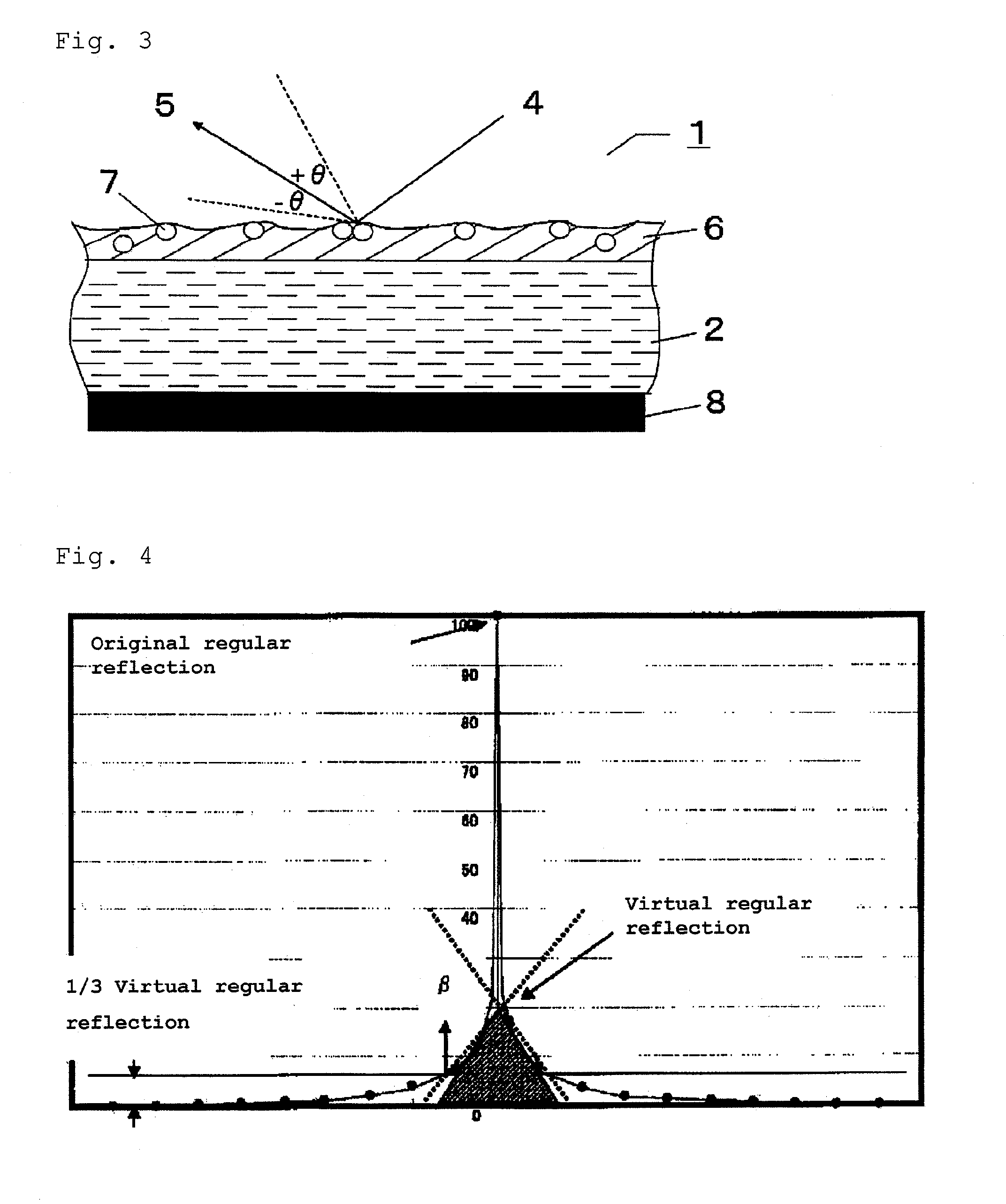Optical sheet
a technology of optical sheets and polarising elements, applied in the field of optical sheets, can solve the problems of not always being stably produced a satisfactory optical sheet, and achieve the effects of reducing contrast, increasing diffusion angle, and satisfying contras
- Summary
- Abstract
- Description
- Claims
- Application Information
AI Technical Summary
Benefits of technology
Problems solved by technology
Method used
Image
Examples
production example 1
[0152]Triacetylcellulose (80 μm thickness, FujiFilm Corp.) was prepared as a base material. The transparent resin used was a mixture of pentaerythritol triacrylate
[0153](PETA), dipentaerythritol hexaacrylate (DPHA) and polymethyl methacrylate (PMMA) (weight ratio: PETA / DPHA / PMMA=86 / 5 / 9) (refractive index: 1.51), and polystyrene particles (refractive index: 1.60, mean particle size: 3.5 μm, (d75-d25) / MV=0.05) and styrene-acrylic copolymer particles (refractive index: 1.56, mean particle size: 3.5 μm, (d75-d25) / MV=0.04) were added thereto as translucent particles, at 18.5 and 3.5 parts by weight, respectively, with respect to 100 parts by weight of the transparent resin. A resin composition, obtained by mixing a mixed solvent of toluene (boiling point: 110° C., relative evaporation rate: 2.0) and cyclohexanone (boiling point: 156° C., relative evaporation rate: 0.32) (weight ratio: 7:3) as the solvent at 190 parts by weight with respect to 100 parts by weight of the transparent resin,...
production examples 2-7
and Production Examples 9-17
[0154]An optical sheet (anti-glare sheet) was fabricated for Production Example 1, changing the type of base material, the type of transparent resin, the types and content of translucent particles, the type and content of the solvent, the drying conditions and the coating film thickness, as listed in Table 1. The results of evaluating each optical sheet in the same manner as Production Example 1 are shown in Table 2.
production example 8
[0155]Triacetylcellulose (80 μm thickness, FujiFilm Corp.) was prepared as a base material. Pentaerythritol triacrylate (PETA, refractive index: 1.51) was used as the transparent resin, and there were added thereto as translucent particles, styrene-acrylic copolymer particles (refractive index: 1.51, mean particle size: 9.0 μm, (d75-d25) / MV=0.04) and polystyrene particles (refractive index: 1.60, mean particle size: 3.5 μm, (d75-d25) / MV=0.05), at 10.0 parts by weight and 6.5 parts by weight, respectively, with respect to 100 parts by weight of the transparent resin. A resin composition obtained by mixing a mixed solvent of toluene (boiling point: 110° C., relative evaporation rate: 2.0) and cyclohexanone (boiling point: 156° C., relative evaporation rate: 0.32) (weight ratio: 7:3) as the solvent at 190 parts by weight with respect to 100 parts by weight of the transparent resin, was coated onto the base material and dry air at 85° C. was circulated at a flow rate of 1 m / s for 1 minu...
PUM
| Property | Measurement | Unit |
|---|---|---|
| diffusion angle | aaaaa | aaaaa |
| refractive index | aaaaa | aaaaa |
| haze | aaaaa | aaaaa |
Abstract
Description
Claims
Application Information
 Login to View More
Login to View More - R&D
- Intellectual Property
- Life Sciences
- Materials
- Tech Scout
- Unparalleled Data Quality
- Higher Quality Content
- 60% Fewer Hallucinations
Browse by: Latest US Patents, China's latest patents, Technical Efficacy Thesaurus, Application Domain, Technology Topic, Popular Technical Reports.
© 2025 PatSnap. All rights reserved.Legal|Privacy policy|Modern Slavery Act Transparency Statement|Sitemap|About US| Contact US: help@patsnap.com



